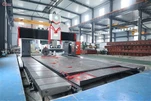Description
Milling is a commonly chosen method for machining the teeth of a gear rack.
Here are several reasons
Versatility: Milling is a versatile machining process that can be used for a wide range of workpiece shapes and sizes. It's particularly well-suited for gear racks, which often come in various lengths and profiles.
High Precision: Modern milling machines are capable of achieving high levels of precision and accuracy in tooth profiles. This is crucial for gear racks, as precise tooth profiles are essential for smooth and efficient gear operation.
Cost-Effectiveness: Milling is a cost-effective method, especially for small to medium production runs. Milling cutters are relatively inexpensive, and the process is well-suited for machining multiple gear racks in a single setup, which can reduce labor and tooling costs.
Customization: Milling allows for easy customization of gear rack profiles. Different tooth profiles, tooth forms, and pitches can be machined to suit specific application requirements.
Faster Production: Milling can be a faster method compared to some other gear manufacturing processes, like broaching or shaping, making it suitable for efficient production.
Reduced Tool Wear: Modern milling machines often come with features like high-quality tool coatings and coolants, which can extend the life of cutting tools. This can result in longer tool life and reduced tool replacement costs.
Automation and CNC Control: Many milling processes are automated and controlled by CNC (Computer Numerical Control) systems, allowing for highly precise and repeatable machining. This is especially beneficial for large-scale production.
Wide Range of Materials: Milling is capable of handling a wide variety of materials, including metals, plastics, and composites, making it adaptable to different applications and industries.
Geometric Flexibility: Milling can produce not only straight-toothed gear racks but also helical or curved profiles, depending on the cutter and toolpath used. This offers flexibility for specific design requirements.
Tool Selection: Various types of milling cutters, such as end mills and side mills, are available for gear rack machining. The choice of cutter can be tailored to the specific gear rack design and material.
summary
While milling is a suitable method for many gear rack applications, the choice of machining method ultimately depends on factors like production volume, required precision, material type, and available equipment. It's important to consider the specific requirements of your project when selecting the most appropriate machining method.







